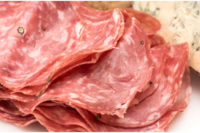“Even slices are what we’re after,” says Fred Sneider, sales manager for Boston Brisket. The company offers corned beef, red and black pastrami and shaved steak for Philly cheesesteaks. The company caters to both the foodservice the retail deli-counter market.
“The most important feature is the feed, that the product is stable and [the equipment] slices with a consistent thickness,” Sneider says. “That means a good hold-down.”
Throughput is a key concern, and Sneider notes that there are a couple of ways that a machine can handle the feed. A gripper feed grabs the product and pushes it through the machine to the blade. Another option is a tractor, or continuous feed.
“The tractor feed has a conveyor on the top and one on the bottom that’s spring-loaded and holds the product. It conveys it to the blade,” he explains.
Ron Tew, vice president of operations for Baltimore-based Deli Brands of America, stresses the value of presentation, particularly for products going to the retail marketplace.
“You need a nice-looking package and nice stacking to make it marketable,” he says. Along with the retail market, Deli Brands produces its sliced deli meats, including roast beef, corned beef and pastrami to the foodservice and institutional markets.
One of the more recent developments in the slicing technology is the equipment’s ability to pre-weigh the packages, which makes the job of getting a presentable package easier. “We look at weighing and stacking abilities so we can make a better-looking stack without having to do a lot of manual work on it.”
Tew adds that equipment manufacturers have put more thought into sanitary design, and notes some of the newest developments in that field.
“Some of the slicing companies are working with the chemical companies to attach spray nozzles with antimicrobial agents right into the machine,” he says. “I think that would have to become standard eventually, because it’s something that everybody’s going to be looking at.”
Tew also notes that slicers are getting better when it comes to disassembly for cleaning.
“If you get one that’s produced within the past five years, you’ve probably got a big advantage, with all the thought that’s gone into it,” he says. “You can’t leave parts bolted together anywhere near the product path, leaving pockets of bacteria that aren’t getting cleaned daily.”
Tew says that keeping the slicer blade in good condition in one simple but effective way to ensure quality product.
“We send ours out [for resharpening] once every couple of weeks, but it should be based on the amount of product that’s been over the blade,” he says.


Report Abusive Comment